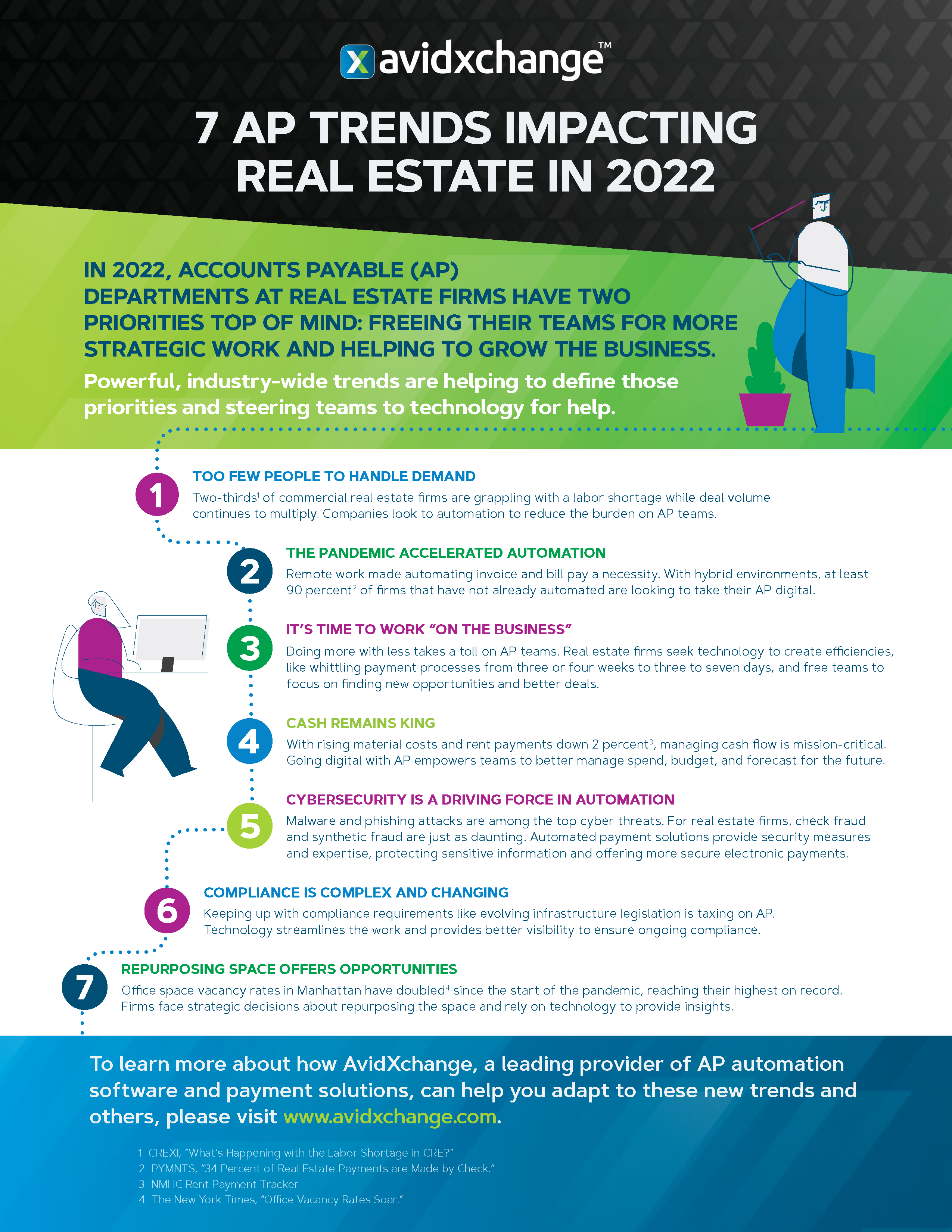The pandemic fundamentally shook accounts payable (AP) departments in real estate — forcing remote work and, in turn, accelerating the adoption of AP automation.
Despite challenges and shifts in the ways of working, the industry as a whole bounced back far better than most, and some segments are experiencing record growth.
How are the AP departments at real estate firms faring as they continue to adjust to changes in processes and workload in 2022?
Real estate firms have two priorities top of mind: How to free their teams for more value-added work and how to grow the business without adding people. They are looking to technology to create the efficiencies they need to excel at both.
Here we explore key trends that are impacting the real estate industry and helping to define these priorities and others in 2022:

CLICK HERE TO DOWNLOAD THE INFOGRAPHIC
This handy guide outlines the five trends expected to impact the way the real estate industry manages its invoices and payments in 2022 and beyond.
1. AP departments at real estate firms are stretched thin
Like most industries, real estate is facing a labor shortage. It’s unique in that it involves multiple layers. Onsite property management and leasing offices are experiencing high turnover, as is expected with entry-level jobs that are seen as stepping stones to the young professionals who fill them. Typical turnover has accelerated and magnified, though, due to increases in job-hopping brought on by the pandemic, leaving more spots to fill.
Back office, corporate teams have another challenge impacting hiring: Older decision-makers are reluctant to adopt AP technologies. Many real estate stalwarts have an “if ain’t broke, don’t fix it” mentality when it comes to invoices and payments. Their reluctance taxes their productivity and hinders their ability to attract younger hires who can instead opt for a more tech-savvy employer.
Some real estate firms spend days manually logging thousands of invoices into their accounting system. The new generation of AP professionals isn’t willing to do the cumbersome work or take on the risk it exposes, like the risk of incorrectly entering data or making double payments.
In its annual commercial real estate (CRE) innovation report, Altus Group asked CRE executives: “What impact do you think automation in the CRE industry will have on jobs?”
The top five responses were:
In 2022, we’ll likely see more firms looking to adopt automation in order to take the burden off their teams, make work more fulfilling, and to attract new hires that are necessary for business continuity and growth.
2. Increased adoption of AP automation
The adoption of AP automation accelerated during the pandemic because it became a necessity: Businesses needed it to run their operations remotely and ensure that their vendors and suppliers got paid on time. Without it, they were carting check printers to their homes and driving around town for sign-offs.
While checks payments still make up 34 percent of B2B payments in the commercial real estate market, at least 90 percent of firms who have not already automated are looking to digitize their accounting operations.
End-to-end automation solutions—from invoice to payment— can create more efficient processes, save time and money, eliminate the need for additional headcount, and free time for more strategic work.
It’s expected that as firms realize the host of benefits and look for competitive advantage, they’ll continue to move toward complete automation solutions. Some firms are also investing in automated rent collection portals and subsets of the industry like parking lots in big cities are curious about hyperautomation, like machine learning, that can enable worker-less environments.
3. Overcoming 'keyman' risks
As industry conferences and trade shows resumed last year, there was a buzz of conversation around under-staffed AP groups and the risks they exposed.
As property management firms expand, there’s extra workload to contend with. Rather than hiring an additional AP professional, many teams take on more work, forcing staff to do more with less time. It can be a drain on smart people’s time and energy.
And, it’s a recipe for disaster. Overworked humans burdened with repetitive, manual tasks are susceptible to making errors.
What’s more, there’s the keyman risk. It’s what happens when only one person knows how things work. What happens when he or she leaves the company? Loss of data and disruption to processes is inevitable.
Companies are aiming to avoid these risks. They are also looking for ways to clean up vendor profiles, freeing their AP team’s time and leveraging it to identify expense efficiencies, find new vendors, and to secure bundle pricing. Expect to see more companies focused on their teams working on the business versus working in the business.
4. Leveraging data to control cash flow
There’s a common myth in real estate AP departments: Doing things manually gives greater transparency. It’s simply not true.
While some firms have feared losing control to AI, the technology, in fact, provides more transparency, control and efficiency. Real estate firms are leveraging the newfound data it provides to better control their cash flow.
With rising material costs and rent payments, for instance, down 2 percent on average compared to 2019, cash has taken on newfound importance.
As teams digitize accounts payables, they can better analyze spend and more accurately budget and forecast for the future. From a payments standpoint, processes that used to take 20 to 30 days from invoice to payment, can be whittled down to three to seven days, further aiding cash management.
In 2022, real estate firms will look at their data and the insights it provides to find property improvement and vendor management opportunities. They will be able to understand profitability levels throughout locations and integrate this info with reporting systems that integrate with AP, AR and accounting systems.
5. Growing awareness of cybersecurity threats
There were an estimated 4.8 million identity theft and fraud reports received by the Federal Trade Commission in 2020. That’s up 45 percent from the previous year. In real estate, the threat has been a driving force in automation.
Firms victimized by cybercrime often turn to automation, looking to do what they realize they should have already done. It’s also not uncommon for automation providers to find evidence of an attack while onboarding new clients. The firms may have no idea that they’d been victimized.
In addition to phishing attacks and check fraud, the real estate industry is susceptible to synthetic fraud, occurring when criminals combine separate pieces of real and fake personal data, such as social security numbers and addresses, to create a fake person. It can be used, for instance, to rent an apartment.
In 2022, firms will look to their automated AP solutions to help ward off threats by taking on responsibility. When they adopt an automated payment system, they transfer risk to the automation provider — who has expertise and strong security measures in place — reducing the risk of criminals accessing sensitive information and also reducing the risk of check fraud.
6. Ongoing compliance challenges
AP compliance requirements continually evolve and become more complex with recent changes to IRS reporting rules, impending 2023 data privacy regulations, and an enhanced emphasis on enforcement of the Corporate Transparency Act and the Anti-Money Laundering Act. Scrutiny over adherence has become more intense as regulators have better access to large quantities of financial data, thanks to electronic record keeping.
Keeping up with compliance requirements is a heavy lift, especially for firms that deal with multiple vendors and do work across state lines. The responsibility and the time-consuming tasks it involves fall on accounting teams.
Recent federal legislation has heavily focused on infrastructure, including tax and capital gains related to real estate and infrastructure. Real estate companies don’t yet know how changing legislation will impact them, but they’re smart to put systems in place that will help them react to possible reporting changes without enduring a massive burden on their business.
In 2022, firms look at purchasing and AP regulations training to help them avoid compliance issues and the costly penalties and lawsuits that can accompany them. They also look at technology to streamline the work, provide better visibility into the invoice approval process, and reduce the need for human interaction which can often lead to error or oversight.
7. Continued reimaginging of real estate space
According to an article in the New York Times, 18.7 percent of all office space in Manhattan, home to two of the country’s largest business districts, was available for lease in the summer of 2021. That’s more than double the vacancy rate pre-pandemic. Los Angeles, Chicago and other cities with high concentrations of commercial space are experiencing similar vacancy rates.
What’s happening to office and retail space left unoccupied since the start of the pandemic? It’s still relatively unknown, as the spaces tend to be linked to three to five-year leases and owners are content to wait it out while continuing to receive rent for unused space.
Over the current and coming years, owners face tough, strategic decisions about what to do with the space, deciding, for instance, whether to convert to residential units, flex workspaces to accommodate new hybrid work environments or create entirely new purposes.
Liberating themselves from manual AP tasks and leveraging newfound data and trends revealed by automated solutions will enable them to put their time and efforts into strategizing their next move.



